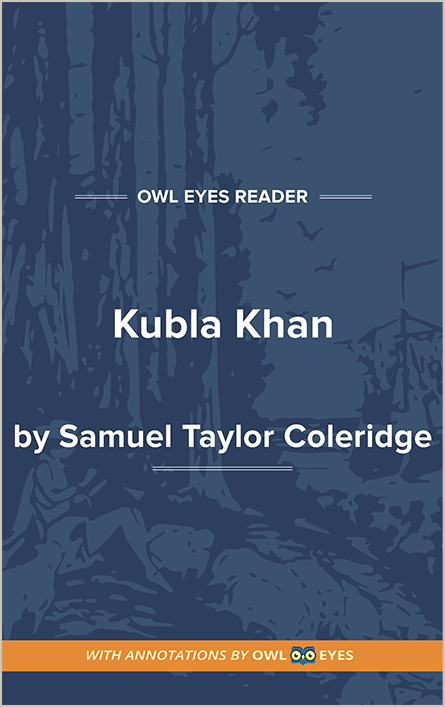Analysis Pages
Literary Devices in Kubla Khan
Coleridge’s Introduction and Subtitle: When he published “Kubla Khan” in 1816, Coleridge chose to add a new introduction and subtitle to the 1797 poem. In the introduction, Coleridge describes an evening spent reading Samuel Purchas’s account of Xanadu. Coleridge eventually drifted off into an opium-induced slumber, in which he dreamed up a resplendent vision of Xanadu. He awoke and, bursting with inspiration, began furiously writing down his vision in lines of poetry. His efforts were interrupted, however, by a knocking at the door, a “person from Porlock.” Thus, the final poem represents Coleridge’s subsequent attempts to reconstruct his “vision in a dream,” resulting, as the subtitle warns us, in a mere “fragment.” Or so Coleridge claims. The poet’s backstory to the poem emphasizes one of its main themes: the imperfection of art. Coleridge writes of having experienced a vision of perfection, an aesthetic ideal that—due to external circumstances—he was unable to reproduce through poetry. The truth is that, no matter the circumstances, artistic endeavors are flawed in some way or another.
Form, Structure, Meter & Rhyme: Coleridge did not adhere to any preexisting poetic form in his writing of Kubla Khan. The structure consists of three stanzas of 11, 25, and 18 lines, respectively. The meter fluctuates several times between tetrameter and pentameter, with occasional bursts of trimeter. The result is a loosely flowing poem, whose metrical shifts signal thematic shifts. This phenomenon is most apparent in the transition from the second to the third stanza, where the jump from pentameter to tetrameter accompanies a self-reflexive leap in the poem’s perspective. As with the metrical scheme, the rhyme scheme is loose and varied. Rhyme schemes that appear in the poem include ABAAB, ABAB, ABBA, ABBBA, as well as rhymed couplets, all of which interlace without reason or pattern. Coleridge’s largely scattered approach to meter and rhyme reflect the poem’s theme of the imperfection of art.
Literary Devices Examples in Kubla Khan:
Kubla Khan
🔒"In a vision once I saw:..." See in text (Kubla Khan)
"And drunk the milk of Paradise...." See in text (Kubla Khan)
"And all should cry, Beware! Beware!..." See in text (Kubla Khan)
"I would build that dome in air, That sunny dome! those caves of ice!..." See in text (Kubla Khan)
"Or, a vision in a dream. A fragment...." See in text (Kubla Khan)

